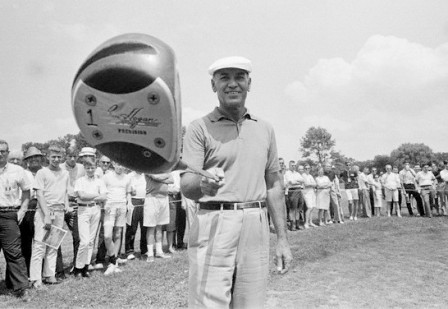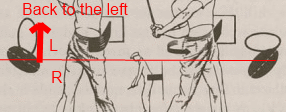It’s a critical move… module #2 students will understand what is happening, how and why. It’s not a dragging foot as some suggest. Think of if more as a grinding foot. It’s not a passive sliding across the ice. It’s pressured.

is that the proper hogan swing plane?
youtube.com/watch?v=AEGMkxK4 … re=related
Yes, it is very good. Dr Wood is a fine ball striker. His excellent golf swing has developed from using persimmon and blades also.
Nice view of Mr. Hogan’s grip here:
[youtube]- YouTube
Had probably the most eye-opening day and flushed things like they were meant to be flushed…hit nearly anything I looked at and it was due to seeing Hogan’s stance in a different way for the first time. Allow me to explain.
Conventional instruction, and Hogan’s book for that matter, when talking about feet placement centers around the restrictive, or active, qualities allowed or disallowed by each foot. For instance, In Five Lessons Hogan basically says that the 22* flared L foot allows freedom of movement toward a target etc., and the squared R foot restricts hip movement, etc. These aspects are taught as though they are primary concerns in placing the feet. I believe Hogan may not have revealed another aspect of feet placement which I feel is primary…making the active and restrictive aspects secondary.
The placement of the feet is a way to oppositionally control two seperate forces occurring at the same time through the zone: outward and forward.
The flared L foot is an assist mechanism tied to the orbit pull, and the 22* placement relationship is nearly perpendicular to the orientation of what the shoulder line WILL BE just past low point if the shoulders turn flat and left during the orbit pull process. It’s pretty cool how the left foot is deliberately placed to assist fighting CF- which is the outward force as you all know.
The squared R foot, placed after the left foot, will automatically square to the line of flight IF the intention of placement is to fight the forward travel of the club during the same period of time that the orbit pull is in progress. Much like a tug-of-war. If both sides don’t pull equally and in opposite directions, then slack exists. In this case the club is going forward and the right foot is the anchor holding it back momentarily so things don’t go forward too quickly.
So you have outward travel controlled with the orbit pull with a flared L foot anchor, and a forward travel being controlled by the R foot anchor.
You may feel a little more left than usual at setup with this notion and intention…but it is a pressurized stance ready to fight the forces. Just turn it loose and watch it fly.
Don’t know how many will agree but that’s ok. Ratamorphasis is complete and it all begins in the ground. It really is in the dirt afterall. Need to find some 5" spikes ![]()
Well you basically stumbled onto ABS module 2 in your own rat way. Lag’s description is a bit different but there’s no doubt that you two are describing the same phenomenon. Removing slack, maintaining pressure…all noble goals and sensible uses of the ground. It can be wierd because it feels like you can turn faster without digging in deep but the speed is useless; can’t turn it into hand pressure or shaft flex unless you are anchored. There are many people who can play in tennis shoes or sandals and notice no difference. I’ll never be able to do that again and now you probably won’t either.
The pressures in the feet will be slightly different for each player considering a few things such as lie angle of the clubs… how flat they enter and exit the impact arena, what type of release they are using, the dead weight of the gear, acceleration and velocity and so on… but I think your insights are excellent. Thanks for posting
Anyone remember where that picture is of Hogan holding a driver and presenting the sole to the camera in which the scuff marks are at the back of the club. I have a hard time searching the site sometimes. Unless I remember some precise word or phrase that either me or someone else used, I usually have a hard time finding things- especially pictures. ![]()

Thanks Two…
That’s the one in more ways than one ![]()

Heres a thought bubble for you RR. ‘Back to the left’… feels like the arrow direction (behind you to the back - feels like not rotating shoulders). Any thoughts? ![]()
Rat bubbles. Hope Ben doesn’t mind me commenting on his action. What I wouldn’t give to have been able to spend a week or so with him- I would have picked his brains for sure, but in my own kind of way.
I’m a little confused about your diagram. The backward arrow you drew was assigned to the portion of the diagram showing the relationships in the backmove, and the question appears to be aimed at discussing the downmove.
In any event, I don’t believe The Hawk was as descriptive as he could have been in the book. I don’t see the advice about turning the hips actively to the left from the top as sound advice, and I would question if that is what he truly felt. There is a very very slight involuntary lateral move while the hips are compressing in response to the upper assemblies lowering- yet the shoulders are staying put if you will but also experiencing an axis shift…all this is occurring during the free ride.
He says "TURN YOUR HIPS BACK TO THE LEFT. THERE MUST BE ENOUGH LATERAL MOTION FORWARD TO TRANSFER THE WEIGHT TO THE LEFT FOOT.
I think if not inspected properlly, this advice leads to all kinds of issues in my opinion. The question then becomes how much weight to the left foot?
I believe the amount of weight transferred to the left foot during the freedom ride is minimal. I don’t know what my numbers are but guessing I’m 52R-48L at address…80R-20L at the top…and about 70R-30L at P3, maybe 65-35 but somewhere in that range prior to going hard at it. So yeah, the weight did move left but not anywhere near what I think a lot of people assume his admonition was.
I’ve got some time on my hands lately which is never a good thing, but I’ve been playing around with an idea that is challenging but fun. Remember Hogan said reverse every natural instinct or something like that. I’ve been taking his book and writing it backwards. Now some words have no opposites ( which is peculiar in itself ) so a little leeway is allowed- but let’s take part of the all cap phrase above and turn it around using opposite words to read something like this:
THERE MUST BE ENOUGH MEDIAL MOTION BACKWARD TO KEEP THE WEIGHT TO THE RIGHT FOOT.
How about them apples…if you squeese hard enough you get cider. ![]()
Those marks on the bottom of Hogan’s driver are a perfect example of someone who cuts it hard left after impact. I think most people in the traditional golf instruction community would call that person a slicer if they didn’t see who was holding the club!
Cheers,
Captain Chaos
A picture is worth a thousand words, or two pounds of finely aged cheese. ![]()
I agree that Hogan’s book is shrouded in cryptic words and imagery, and this spinning hips diagram may be the most controversial.
I would say however, that combined with superslotting the club at transition, one can very much feel this kind of action.
With the shaft flat, laid off, and the shoulders very rotated with minimal hand travel, the hips can lead very aggressively.
If you swing upright, and have the club up high over your shoulders… the quick hips spin is going to create mostly unwanted results.
Like I mentioned above I would have picked Hogan’s brain in my own kind of way. One pick would have been about turning the left hip- feeling pulled back by a rubber band or something. Not disputing the feel at all, as one feels what they feel, but the left hip lead seems incomplete in my opinon.
I would think the hips function in reciprocal fashion- when the left moves, so does the right. I always liked the feel of the stomach around, and behind, the belly button as the motor in driving that action. The left hip feel being active seems like it is too far away, or removed, from the action. Here’s how I sense it: if I am walking straight ahead down a sidewalk and suddenly turn left, the driver is middle first around the stomach area, then the legs and hips respond to that movement. I don’t know that we turn left by leading with the hip in the direction we’re going…we turn from the middle in all likelihood. Probably a chicken v. egg scenario. Bom had some interesting observations on this too regarding the sides versus the middle of the DNA helix. Do the sides create the middle, or does the middle allow the sides.
I remember some thoughts from Faldo where he actually felt like Stomach and Buttons back and through. Always felt very cohesive to me.
Just some of my thoughts on it is all.
I agree fully…
…but even going a little longer and more upright, with more hand travel, won’t a nice reverse loop during transition present the proper entry corridor wherein the feel question about hip versus stomach presents itself again?
Got me to thinking. Lag, knowing what you know now about dynamics, if you were to take the DeLorean back in time to Ben’s lunch table in Texas and he offered you the opportunity to ask just one question…what would that question be. Any ideas on that. ![]()
Pretty similar intentions if not exact.
Both super slotters, both working the shaft hard left post impact. Both championed lots of major events.

Right hip pocket to left hip pocket. Great visuals here and shows the power of what an effective pivot action can do combined with a strong forearm rotation. Nothing passive going on here. The orbit pull from P3 to P4 drives pressure and feeling into the hands and gives players who apply this method a powerful tool for shaping the golf ball around the course.
Nice link here was emailed over to me a bit ago.

